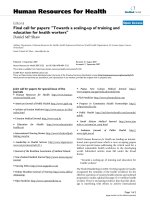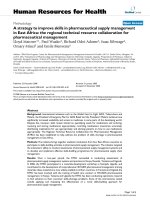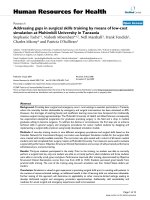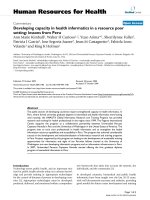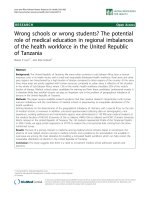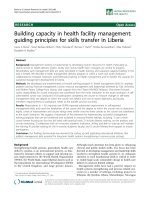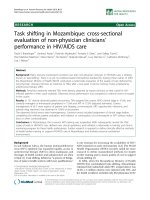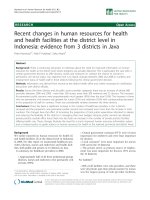báo cáo sinh học:" Addressing gaps in surgical skills training by means of low-cost simulation at Muhimbili University in Tanzania" potx
Bạn đang xem bản rút gọn của tài liệu. Xem và tải ngay bản đầy đủ của tài liệu tại đây (1.15 MB, 10 trang )
BioMed Central
Page 1 of 10
(page number not for citation purposes)
Human Resources for Health
Open Access
Research
Addressing gaps in surgical skills training by means of low-cost
simulation at Muhimbili University in Tanzania
Stephanie Taché
†1
, Naboth Mbembati*
†2
, Nell Marshall
3
, Frank Tendick
1
,
Charles Mkony
2
and Patricia O'Sullivan
1
Address:
1
Global Health Sciences, University of California San Francisco, San Francisco, California, USA,
2
School of Medicine, Muhimbili
University of Health and Allied Sciences, Dar es Salaam, Tanzania and
3
Department of Health Services, School of Public Health, University of
California Los Angeles, Los Angeles, California, USA
Email: Stephanie Taché - ; Naboth Mbembati* - ;
Nell Marshall - ; Frank Tendick - ; Charles Mkony - ;
Patricia O'Sullivan -
* Corresponding author †Equal contributors
Abstract
Background: Providing basic surgical and emergency care in rural settings is essential, particularly in Tanzania,
where the mortality burden addressable by emergency and surgical interventions has been estimated at 40%.
However, the shortages of teaching faculty and insufficient learning resources have hampered the traditionally
intensive surgical training apprenticeships. The Muhimbili University of Health and Allied Sciences consequently
has experienced suboptimal preparation for graduates practising surgery in the field and a drop in medical
graduates willing to become surgeons. To address the decline in circumstances, the first step was to enhance
technical skills in general surgery and emergency procedures for senior medical students by designing and
implementing a surgical skills practicum using locally developed simulation models.
Methods: A two-day training course in nine different emergency procedures and surgical skills based on the
Canadian Network for International Surgery curriculum was developed. Simulation models for the surgical skills
were created with locally available materials. The curriculum was pilot-tested with a cohort of 60 senior medical
students who had completed their surgery rotation at Muhimbili University. Two measures were used to evaluate
surgical skill performance: Objective Structured Clinical Examinations and surveys of self-perceived performance
administered pre- and post-training.
Results: Thirty-six students participated in the study. Prior to the training, no student was able to correctly
perform a surgical hand tie, only one student was able to correctly perform adult intubation and three students
were able to correctly scrub, gown and glove. Performance improved after training, demonstrated by Objective
Structured Clinical Examination scores that rose from 6/30 to 15/30. Students perceived great benefit from
practical skills training. The cost of the training using low-tech simulation was four United States dollars per
student.
Conclusion: Simulation is valued to gain experience in practising surgical skills prior to working with patients. In
the context of resource-limited settings, an additional benefit is that of learning skills not otherwise obtainable.
Further testing of this approach will determine its applicability to other resource-limited settings seeking to
develop skill-based surgical and emergency procedure apprenticeships. Additionally, skill sustainability and
readiness for actual surgical and emergency experiences need to be assessed.
Published: 27 July 2009
Human Resources for Health 2009, 7:64 doi:10.1186/1478-4491-7-64
Received: 5 May 2008
Accepted: 27 July 2009
This article is available from: />© 2009 Taché et al; licensee BioMed Central Ltd.
This is an Open Access article distributed under the terms of the Creative Commons Attribution License ( />),
which permits unrestricted use, distribution, and reproduction in any medium, provided the original work is properly cited.
Human Resources for Health 2009, 7:64 />Page 2 of 10
(page number not for citation purposes)
Background
Surgery as an essential service
Injury is a growing epidemic in East Africa and large num-
bers of injured people are at risk of death and lifelong dis-
ability [1]. Surgery has a major role to play in public
health in the prevention of death and disability in addi-
tion to treating injuries, including obstetrical emergencies
and a wide range of emergency abdominal and non-
abdominal conditions [2-4].
The second edition of Disease control priorities in developing
countries (DCP2) has brought attention to the role of sur-
gery as a public health strategy [5]. The DCP2 estimated
that 11% of all disability-adjusted life years (DALYs) are
from conditions likely to require surgery. Furthermore,
the report demonstrated that surgical services provided in
low-cost district hospitals in resource-constrained coun-
tries are highly cost-effective. Yet a large amount of unmet
need persists, due to untrained health workforce and
inadequate surgical infrastructure in rural areas. One
study in Tanzania used "met need" and "case fatality" to
estimate the contribution of surgical access in two regions
with a combined population of five million. In both
regions, the "met need" amounted to 30%. The DCP2 sug-
gests there is an urgent need to expand the number of
health facilities with the ability to provide access and serv-
ices to emergency obstetrical surgery [5].
One of the primary obstacles to expanding surgical serv-
ices is the relatively few trained surgeons to care for more
than 200 million people in the eight-country region of
East Africa. The limited numbers of medical graduates in
Tanzania are preferentially posted to District Medical
Officer (DMO) positions in rural areas, where they are
expected to perform essential surgical and emergency
obstetric care. Improving the quality of their training is
therefore a means of improving patient outcomes.
Surgical training in Tanzania
The Muhimbili University of Health and Allied Sciences
(MUHAS) trains the greatest number of medical students
in Tanzania. Several challenges have constrained MUHAS'
ability to properly train medical students to serve these
roles.
The medical school has experienced an explosion in the
number of students enrolled in the past five years, without
a proportional increase in teaching resources or faculty. In
surgery, the faculty-to-student ratio has decreased from
1:2 to 1:10, with less individual teaching time – an essen-
tial part of surgical skills apprenticeship [6]. The teaching
space in surgical theatres at the Muhimbili National Hos-
pital, designed to accommodate a maximum of five med-
ical students, is inadequate for the 60 medical students
carrying out their surgical clerkship at any given time. The
surgical curriculum has no dedicated time to supervise
and teach practical skills outside of operating theatre
cases.
Limited space and decreases in surgical case-load due to
major hospital rehabilitation work has resulted in stu-
dents' being able to attend only a handful of surgeries dur-
ing their eight-week surgical clerkship. Lack of preparation
at the medical student level extends into internship, when
interns believe they are ill-equipped to perform the skills
necessary for surgical specialization, which affects their
career choices [7].
The role of simulation in surgical training
One way to improve surgical skills training has been to
transfer parts of the surgical apprenticeship to laboratory
settings, by means of simulation models. Such surgical
training, for example, in tying, suturing and instrument
handling, has been shown to reduce the failure rate after
formal training [8]. Such skills laboratories have been
found to be the type of training rated highest by students
[9]. Early exposure can also improve student attitudes
towards surgery as a career [10,11].
Although there is an increasing amount of literature on
simulated surgical training, we found no published
reports on surgical skills training for medical students in
Africa. The Canadian Network for International Surgery
(CNIS) has had the greatest amount of experience in sur-
gical training with simulation in Africa, with 5000 pri-
mary care physicians in Ethiopia, Malawi, Mozambique,
Tanzania, and Uganda having benefited from training
through the essential surgical skills programme [12].
In order to address the gaps in surgical training of medical
students at MUHAS, we created, implemented and evalu-
ated a low-cost surgical skills curriculum using limited
technology for senior medical students carrying out their
surgery clerkship. The goal of the training was to teach
medical students the fundamental skills and knowledge
required to assist with surgical procedures and feel com-
fortable in the operating room in a context with limited
resources. The purpose of this article is to describe the cre-
ation and evaluation of a surgical skills training course for
senior medical students developed and implemented by
the MUHAS Department of Surgery.
Methods
Curriculum development
To guide the development of the curriculum, we con-
ducted a needs assessment of surgical faculty to determine
the gaps in surgical and emergency procedures training for
the surgery clerkship between what is offered and what is
needed. Seven members of the surgical teaching faculty in
the MUHAS Departments of Surgery, Orthopaedics,
Human Resources for Health 2009, 7:64 />Page 3 of 10
(page number not for citation purposes)
Obstetrics and Anaesthesiology were interviewed individ-
ually to get their feedback on the skills actually taught and
those they believed students were missing. The Canadian
Network for International Surgery (CNIS) surgical train-
ing curriculum used to train interns, registrars and pri-
mary care consultants at the Muhimbili National Hospital
was also reviewed as part of the needs assessment. Based
on these findings, the CNIS curriculum was adapted with
the overall goal of improving essential surgical and emer-
gency skills. The two-day curriculum covered nine skills in
the fundamentals of assisting in the operation room
(OR), general surgical skills, anaesthesia skills and emer-
gency obstetrical skills (Table 1).
Curriculum Implementation
The planned curriculum included five one-hour training
sessions over a two-day period held in the MUHAS
Department of Anatomy Laboratory. Thirty-six of the 60
eligible students (60%) agreed to participate. They were
divided into two groups of 18 for convenience purposes
and completed the two-day training course after complet-
ing their mandatory eight-week surgery rotation (Figure
1). Students were arranged three to four per laboratory
table, with eight surgical faculty, surgical technicians and
surgical nurses providing instruction at each session
(Table 2). Thus we had a student-faculty ratio of 3:1 to
ensure the optimum recommended by current research
[13]. For each of the five skills being taught each day, fac-
ulty members gave a five-minute introduction followed
by 55 minutes of hands-on instruction (Table 1). Students
rotated through five stations each day. The knot-tying sta-
tion was repeated on the second day of the training, as it
was deemed an essential skill for students to master.
Table 1: List of skills taught, with length of time and materials used for the surgical skills training course
Surgical skills Objectives Time in curriculum Models used
Scrubbing, gowning & gloving (OSCE) To demonstrate proper techniques for
surgical scrubbing and donning of
surgical gowns and gloves while
maintaining sterile field
55 minutes Cloth theatre gowns, plastic gloves
Patient preparation To demonstrate proper technique for
patient skin sterilization to prepare field
prior to surgery
55 minutes Wood bench draped with plastic with
abdominal landmarks (Figure 2)
Surgical knot tying (OSCE) To demonstrate proper knot tying
techniques and their indications
110 minutes Ethicon knot tying models (Figure 3)
Venous cutdown (OSCE) To learn indications for venous cutdown;
identify the anatomical location of long
saphenous vein; perform a venesection
using simulated leg
55 minutes Plastic tube placed on arm stabilizer
covered with foam & vinyl
Adult intubation (OSCE) To demonstrate technique for adult
intubation: visualize laryngeal cords,
insert endotracheal tube and properly
ventilate using an ambu bag
55 minutes Adult intubation mannequin
("Airway Larry")
Chest tube insertion To state the indications for chest tube
insertion and demonstrate the technique
for chest tube insertion
55 minutes Teaching skeleton rib cage draped with
foam & vinyl (Figure 4)
Laparotomy (OSCE) To open anterior abdominal wall using
midline incision and close abdomen in
layers using mattress sutures
55 minutes Wood frame with foam, clear &
colored vinyl (Figure 5)
Small bowel repair To understand the principles of bowel
repair and perform repair of perforated
bowel
55 minutes Inner tubes from bicycle tires
(Figure 6)
Vacuum-assisted vaginal delivery To know the indications for vacuum-
assisted delivery; demonstrate
positioning of suction cup and proper
guidance of the delivery
55 minutes Obstetrical mannequin
Human Resources for Health 2009, 7:64 />Page 4 of 10
(page number not for citation purposes)
Table 2: Budget and work-hours for surgical skills training
Budget & personnel
Supplies
Item Quantity Cost/Item (USD) Total (USD)
Local consumable surgical supplies 37 15 555
Certified instructor work-days 36 40 1440
General course support work-days 12 40 480
Total 2475
Work-hours
Person Number Hrs/day No. days Total
Surgical faculty 4 7 4 112 h
Surgical technicians 4 7 5 140 h
Training coordinator 2 2 6 24 h
Administrator 1 2 3 6 h
Student organizer 2 2 2 8 h
Total 290 h
Surgical skills study designFigure 1
Surgical skills study design.
8-Week
Sur gery
Rotation
2-Day
Sur gical
Skills
Trainin
g
Post-Test
OSCE
+
Sur vey
Pr e-Test
OSCE
+
Sur vey
Human Resources for Health 2009, 7:64 />Page 5 of 10
(page number not for citation purposes)
To teach students operating room etiquette with proper
scrubbing, gowning, gloving and maintaining a sterile
field, we worked with two operating-theatre nurse teach-
ers. For the knot-tying and suturing instruction, we used
the Ethicon Knot Tying Manual [14]. For the surgical
abdominal incision, bowel anastomosis, vacuum extrac-
tion delivery and chest tube insertion stations, we worked
with surgeons who had taught these skills in prior CNIS
training courses at MUHAS.
Models used for the training course are listed in Table 1.
The patient-preparation station consisted of a wooden
bench draped with plastic on which abdominal anatomi-
cal landmarks were drawn. A colored solution was used in
lieu of iodine for cleaning (Figure 2).
For the tying and suturing stations, we used coloured
ropes and several types of sutures (2-0 vicryl, 2-0 prolene
and 2-0 silk). Ethicon boards were used to practise knot
tying; handcrafted procedures boards were used to prac-
tice suturing (Figure 3).
The venous cutdown model consisted of a firm plastic
tube placed on an arm stabilizer covered with foam and
opaque vinyl. Students were to identify the anatomical
location of the long saphenous vein on themselves, then
perform a venesection and insert the intravenous cannula
into the vein of the model and secure the cannula in place.
The intubation station was carried out using adult intuba-
tion mannequins ("Airway Larry," Nasco Health Care)
and adult laryngoscopes. The chest model used to teach
chest tube insertion consisted of a teaching-skeleton rib
cage draped with layers of foam and opaque vinyl that
were sewn shut (Figure 4). Students were to review anat-
omy on a volunteer male student, isolating the fifth rib on
the anterior axillary line, insert the chest tube in the man-
nequin, secure the tube in place with suture, and close the
chest tube opening with a suture upon removal of the
tube.
For the laparotomy station, an abdominal frame consist-
ing of a square wood frame covered with three layers of
foam, clear vinyl and colored vinyl, respectively, was used
(Figure 5). Students practised how to open the abdomen
by midline incision and close the abdomen in layers with
mattress and tension (retention) sutures.
For the small-bowel repair station, we used inner tubes
from bicycle tires to mimic small bowel (Figure 6). Stu-
dents learned how to make a perforation and repair the
perforation without narrowing the bowel lumen.
For the vacuum-assisted vaginal delivery, we used an
obstetrical mannequin on which students practised
Picture of bench draped with polythene sheet for a patient preparation stationFigure 2
Picture of bench draped with polythene sheet for a
patient preparation station.
Picture of foam suturing boards for knot-tying and suturing skills stationFigure 3
Picture of foam suturing boards for knot-tying and
suturing skills station.
Picture of skeleton model for chest tube insertion skills sta-tionFigure 4
Picture of skeleton model for chest tube insertion
skills station.
Human Resources for Health 2009, 7:64 />Page 6 of 10
(page number not for citation purposes)
appropriate placement of the vacuum on the fetal head
and developed proper delivery traction with the vacuum.
The total budget for these materials was USD 555, out-
lined in Table 2. The obstetrical mannequin and one of
the adult intubation mannequins, as well as the surgical
instruments, belonged to MUHAS. Additionally, sutures
and an extra intubation mannequin were donated by the
University of California San Francisco (UCSF) Global
Health Sciences.
Development and execution of the training required a
total of 290 work-hours (Table 2). The execution of the
surgical skills training required a total of 252 hours of fac-
ulty teaching time. The surgical faculty contributed an
additional eight hours in curriculum development meet-
ings. The chairman of the Department of Surgery at
Muhimbili University coordinated and oversaw the entire
process. The ultimate goal of the training was to provide
opportunities for medical students to have hands-on
apprenticeship of surgical skills outside the operating the-
atre.
Evaluation
The study design was a pre/post evaluation of a training
intervention in a cohort of Tanzanian senior medical stu-
dents carrying out their surgery clerkship at Muhimbili
University (Figure 1). For ethical reasons, all 60 students
enrolled in the surgical clerkship were offered the option
to participate in the training. The inclusion of a control
group from this same cohort would have entailed repeat-
ing the surgical skills training workshop for this group
after study completion for ethical reasons. However, we
did not have the human resource capacity to carry out this
second training; for this reason, a pre/post evaluation of
the training intervention was agreed upon.
Students were evaluated by means of two methods – a
questionnaire survey and an Observed Structured Clinical
Examination (OSCE) – before and after participating in
the two-day surgical skills training course. The surgical
performance evaluation was used only to measure effec-
tiveness of the training, and was not incorporated into stu-
dents' final grades for their surgery clerkship. This study
was performed with the approval of the Muhimbili Ethics
Committee and the UCSF Institutional Review Board.
Students completed pre- and post-training questionnaires
to measure self-perceived confidence in performing select
surgical procedures. After training, they also provided
their overall satisfaction with the training. Quantitative
data gathered also included demographic data, informa-
tion on previous surgical experience, and whether stu-
dents envisaged surgery to be part of their future clinical
practice and career. The surveys rated student confidence
in each of the skills listed in Table 1. Students rated their
confidence on a five-point Likert scale, or (1) "Very
unconfident" to (5) "Very confident". The post-training
survey also included qualitative questions on how the
training changed students' perception of practising sur-
gery as well as recommendations for improvement of the
training.
The OSCEs that measured baseline surgical skills perform-
ance and acquisition of skills as a result of the training
focused on four of nine skills taught during the course that
were identified as most relevant and measurable (Table
1). Because the same teaching faculty members evaluated
the OSCEs and were not blinded as to whether the stu-
dents were at the pre-course or post-course stage, a strict
Picture of model used for laparotomy skills stationFigure 5
Picture of model used for laparotomy skills station.
Picture of inner tube models for bowel anastomosis stationFigure 6
Picture of inner tube models for bowel anastomosis
station.
Human Resources for Health 2009, 7:64 />Page 7 of 10
(page number not for citation purposes)
grading system for the skills being observed was devel-
oped and agreed upon prior to the exams.
To minimize biased ascertainment of the outcome, faculty
members were instructed to adhere to the same grading
system. Four to six critical steps were identified for each
skill observed, and were evaluated as performed correctly
or incorrectly by the observing faculty, for a total of 30
possible points over the five rated skills. For example, for
the scrubbing, gowning and gloving station, five steps
were scored: washing in the fingers to elbow fashion; drip
drying with hands-up technique; drying hands correctly,
making sure not to repeat same site; donning gloves with-
out touching fingerstalls; and doing up the gown properly
without breaking the sterile field.
We calculated descriptive statistics for the items on the
survey including percentages, means and standard devia-
tions. We used matched paired t-tests to compare per-
formance pre- to post for those students participating in
the surgical skills study. We also calculated effect sizes to
identify the magnitude of the effect of the intervention
independent of sample size. Effect sizes exceeding 0.8 are
considered large [15].
While completing the post-test survey, students were also
asked to respond to two open-ended questions: "How has
this training changed your perceptions about practising
surgery?" and "How would you improve this training?"
These written, qualitative responses were entered into an
Excel database and reviewed independently by two
researchers to identify general themes. The qualitative
data were then coded and organized within these themes,
based on their frequency.
Results
Thirty-eight of 60 eligible fifth-year medical students who
had completed their eight-week surgery clerkship con-
sented to participate in the study. We could match pre-
and post data for 36 of the participants. Twenty-four of
the participants were male and 12 were female. Their aver-
age age was 26 years (range 22 to 34). All participants
anticipated practising general surgery after completing
medical school. Seventy seven percent of participants
reported they were likely or very likely to practise general
surgery, while 33% stated they were somewhat likely to
practise surgery.
Students reported a low number of times scrubbing into
the OR, suturing or knot-tying prior to the training course.
Among participating students, the average number of
times entering the operating theatre was seven, with 84%
of the students estimating they had observed a surgical
procedure 10 times or less; 70% of the students reported
scrubbing and gowning for a procedure one to five times.
Twenty-one percent of the students had no prior opportu-
nity to practice suturing (an average of 1.4 times/student),
while 46% had not performed surgical knot-tying (an
average of 2.4 times/student) during their surgery rotation
(Table 3).
Students scored an average of 6.3 out of 30 points (SD
3.2) on the pre-training OSCE. No student was able to cor-
rectly carry out the steps for a surgical hand tie or an
instrument tie. Only one student was able to perform the
correct steps for adult intubation; three out of 36 students
were able to correctly scrub, gown and glove (Table 4).
Performance on the post-training OSCE demonstrated a
fourfold improvement in skill. Scores increased by 19.4
points (SD 4.0). Improvements were most significant for
knot-tying skills, with a 3.39-point mean increase in skill
for the instrument ties and a 4.86-point mean increase for
the hand ties (Table 4). Eighty-six percent of students (20/
36) were able to correctly perform an instrument tie and
63% (23/36) were able to perform a surgical hand tie after
the surgical skills training; 81% of the students (31/36)
correctly performed the steps for adult intubation. Gains
in surgical skills after the training were lowest for venesec-
tion, with only 27% (10/36) of the students performing
Table 3: Surgery rotation experience for students participating in surgical skills training
Frequency in number of
times
Number of students reporting having engaged in specified activity during their surgery rotation
Observed a surgery in
operating room
Scrubbed & gowned for a
surgical case
Opportunity to suture Practise surgical knot-tying
0 0/37 0/37 8/37 17/37
1 to 5 15/37 26/37 27/37 19/37
6 to 10 16/37 10/37 1/37 1/37
>10 6/37 1/37 1/37 0/37
Human Resources for Health 2009, 7:64 />Page 8 of 10
(page number not for citation purposes)
all the correct steps (mean score 3.8/5), and laparotomy,
with 33% (12/36) correct performance (mean score 4.0/
5) (Table 4).
Eighty-nine percent of the respondents strongly agreed
that the training was a valuable use of their break time,
believed it would help them provide better patient care
and would recommend the training to other medical stu-
dents.
The training changed their perception about practising
surgery. Of the 37 students who completed the surveys, 28
contributed qualitative feedback. Students reported an
increase in willingness and preparedness to carry out sur-
gery after the training. Comments from participants
included: "I am starting to change my mind for practicing
surgery in the future while before I was thinking of inter-
nal medicine". Post-training survey results reflect this phe-
nomenon where students commented: "Despite not
having considered surgery as an option in what I wanted
to specialize at the beginning, I have realized it much
more interesting than it seemed and I can learn, practice
and be good at it."
Improvement themes related to wanting longer duration
of training and broadening of the skills covered to include
procedures such as caesarean section. There was overall
satisfaction with the manner in which the skills were
taught (hands-on apprenticeship with oral guidance) and
the individual attention each student received to learn the
skills. However, the two days of training did not signifi-
cantly change self-perceived confidence levels of surgical
skills or participants' likelihood to practise general surgery
after medical school.
Discussion
Surgical training at MUHAS
Although the acquisition and mastery of basic surgical
procedures, trauma management and emergency obstetri-
cal skills are essential for medical graduates, the quality of
surgical training at Muhimbili University has declined in
recent years. This study highlights how surgical training
has been affected at the medical student level. The decline
in surgical training is reflected in the low mastery of prac-
tical skills in the pre-training OSCE. While students may
have the opportunity to enter the operating theatre, there
is little opportunity to practise surgical skills in the current
training context.
Reasons why students have limited opportunity to assist
in surgeries are most likely related to the expanding
number of students needing to be accommodated during
surgery clerkships. Thus, even though five students are
allowed to scrub into an operation at any given time, it is
impractical for all of them to assist on the case. The intro-
duction of simulation in teaching surgical skills is a feasi-
ble solution to redressing surgical performance in this
group. The need to emphasize surgical skills mastery at
the medical student level is important for the purpose of
improving quality of patient care, but also to increase the
odds of students' pursuing surgical practice or surgery as a
career.
Training effectiveness
The use of low-fidelity and low-cost simulation has been
demonstrated to be an effective alternative to high-fidelity
computer simulation [16-18]. This was confirmed in our
study with measurable improvements in performance
before and after exposure to surgical skills training inter-
vention, as demonstrated by the increase in OSCE scores.
Our effect sizes were large, indicating that the significant
improvement was most likely related to the intervention
and not sample size.
Although we believe the increase in performance was a
result of increased skill performance, there are other
potential explanations for this increase independent of
actual performance. One possibility is that performance
Table 4: Mean score improvement in surgical skills OSCE evaluation
Pre-OSCE Post-OSCE Mean Difference SD p Effect size
Scrubbing, gowning & gloving 2.74 4.51 1.77 1.14 <.001 1.55
Hand knot-tying 0.43 5.29 4.86 1.15 <.001 4.23
Surgical knot-tying 0.03 3.41 3.39 1.06 <.001 3.20
Venous cut down 1.57 4.71 3.14 1.44 <.001 2.18
Laparotomy 0.71 4.13 3.41 1.28 <.001 2.66
Adult intubation 1.41 3.94 2.53 1.49 <.001 1.70
Human Resources for Health 2009, 7:64 />Page 9 of 10
(page number not for citation purposes)
improvement was a result of rater bias or expectations
from the non-blinded faculty raters. We believe that the
OSCE rating system we developed focusing on the grading
of discrete skills mitigates the likelihood of rater bias.
Other explanations for performance improvement not
related to the two-day course include short-term Haw-
thorne effects (the natural improvements that occur from
receiving attention), the effect of repeated observation
and the effect of repeated testing. We believe that the mag-
nitude of the improvement, as indicated by the large effect
sizes, combined with the complexity of skills being
taught, cannot be a result solely of these factors. However,
it is possible that all these factors influence the magnitude
of the increase in performance seen in our cohort of par-
ticipants.
The confidence levels reported by students were not sig-
nificantly changed by the exposure. One reason for this
may be that the duration of the training was not long
enough for students to boost their self-confidence in per-
formance.
This study capitalized on existing expertise in teaching
surgical skills at MUHAS, a result of CNIS annual training-
of-trainers workshops in surgical skills since 2003. Eight
of the 19 teaching faculty members in the MUHAS
Department of Surgery trained in this way took part in the
study. Beyond the monetary resources to build such a cen-
tre, the presence and availability of teaching faculty versed
in pedagogical methods for surgical skills are essential to
the effectiveness of the training.
Cost of training by means of simulation
We used low-technology models with locally available
supplies to carry out the surgical skills training. Except for
the Ethicon boards, the adult intubation models and
obstetric mannequins, all models were locally produced
at minimal cost. As there was an outbreak of West Nile
virus at the time we performed the training, animal mod-
els were replaced by man-made models of wood, foam,
rubber and vinyl. This eliminated many of the procure-
ment, storage and disposal complexities associated with
prior training courses conducted at MUHAS. One of the
unintended consequences of this event was a considerably
reduced materials cost of USD 15 per student (Table 2).
Although some may question the fidelity of models made
of wood, foam and vinyl to actual surgical cases, studies
have shown that even low-fidelity simulation can
improve skill levels [16,17].
Impact on career choices
Irrespective of whether medical graduates choose surgery
as a final career path, having proficiency in essential surgi-
cal and emergency obstetrical skills is necessary for Tanza-
nian physicians. This is due to the structure of medical
training in Tanzania, where medical graduates are
expected to practise in rural settings for one to three years
after completing internship.
MUHAS has a strong culture of public service, and there is
an underlying expectation that medical graduates will
adopt rural postings upon completing medical school.
This expectation is reflected in our study, where partici-
pants reported a high likelihood that they would be
required to perform surgery in the future on both the pre-
and post-training surveys. Thus, students were able to gain
a basic level of mastery and begin entertaining the possi-
bility of practising surgery as a career choice.
In addition to the implications for quality of patient care,
surgical training has implications for the future produc-
tion of surgeons in Tanzania. Although no data exist to
determine what proportion of MUHAS medical graduates
actually end up staffing district hospitals and working in
rural areas, a study in 2003 to determine employment pat-
terns of MUHAS graduates found that 76% of medical
graduates eventually took advantage of opportunities for
additional training [19]. In view of this high proportion of
graduates going on to receive additional training, deter-
mining the extent to which additional skills training in
medical school affects their selection of surgery as a career
choice for postgraduate training is important for the
future production of surgeons.
Feelings of inadequacy ultimately affect career choices:
students who are plagued with preoccupations of incom-
petence about their skill levels do not end up in a field
they feel they cannot master. Several students described
surgery as something unattainable for them because the
skills were too difficult to acquire. When the surgical proc-
ess was demystified, students were able to gain a basic
level of mastery and begin entertaining the possibility of
practising surgery as a career choice.
Conclusion
The use of simulation in teaching surgical skills fills an
essential gap for which there is no substitute. Surgical
skills learning facilities provide an educational environ-
ment in which protected time can be devoted to the devel-
opment of a wide range of skills. Although these facilities
are not intended to replace the learning derived from real
clinical experience, they do enable the learners to estab-
lish a foundation in a range of skills that can subsequently
be honed and made more substantial through experien-
tial learning in surgical practice.
One limitation of this study is the lack of longitudinal
data to demonstrate whether these skills were retained
over time. Further study is required to measure the longer-
Publish with BioMed Central and every
scientist can read your work free of charge
"BioMed Central will be the most significant development for
disseminating the results of biomedical research in our lifetime."
Sir Paul Nurse, Cancer Research UK
Your research papers will be:
available free of charge to the entire biomedical community
peer reviewed and published immediately upon acceptance
cited in PubMed and archived on PubMed Central
yours — you keep the copyright
Submit your manuscript here:
/>BioMedcentral
Human Resources for Health 2009, 7:64 />Page 10 of 10
(page number not for citation purposes)
term impact of such training with regard to skill retention
and performance.
In order to redress the decline in surgical apprenticeship
highlighted by this study, MUHAS, in association with
CNIS and UCSF, will build a surgical skills laboratory on
the main campus. Teaching of essential surgical proce-
dures will therefore be integrated into the MUHAS curric-
ulum in the near future so that students may learn skills
that are otherwise not attainable. Plans to measure skill
sustainability and readiness for actual surgical and emer-
gency experiences will be imbedded into this programme.
List of abbreviations
CNIS: Canadian Network for International Surgery;
DALY: disability-adjusted life year; DCP: disease control
priorities; DMO: District Medical Officer; MUHAS:
Muhimbili University of Health and Allied Sciences; OR:
operation room (or OT: operating theatre); OSCE:
Observed Structured Clinical Examination; UCSF: Univer-
sity of California San Francisco.
Competing interests
The authors declare that they have no competing interests.
Authors' contributions
NB and ST contributed equally to the development of this
manuscript and share first co-authorship. Additionally,
NB participated in the needs assessment and curriculum
design and coordinated the entire study; ST contributed to
the study design and data collection; NM carried out data
analysis and assisted with logistics and procurement of
equipment and drafting of the manuscript; FT contributed
to the study design and manuscript writing; CM provided
writing assistance; PO assisted with data analysis and
manuscript writing. All authors read and approved the
final manuscript.
Acknowledgements
The authors wish to thank the MUHAS Anatomy and Histology Depart-
ment for allowing the use of their laboratory space to conduct the study.
We would like to acknowledge and thank the Canadian Network for Inter-
national Surgery for allowing us to adapt their essential surgical skills cur-
riculum, and for the use of their surgical instruments during the training.
Finally, we wish to thank the MUHAS students for their participation. This
study was funded through a grant from the Chiron Foundation.
References
1. World Health Organization: Working Together for Health: The World
Health Report 2006 2006 [ />whr06_en.pdf]. Geneva: WHO
2. Nordberg E: Injuries in Africa: A review. East African Medical Jour-
nal 1994, 71:339-345.
3. World Health Organization W: Surgical and emergency obstet-
rical care at first referral level. Aide-Memoire [http://
www.who.int/surgery/publications/Aide-MemoireEESC.pdf].
4. World Health Organization W: Global Initiative for Emergency
and Essential Surgical Care (GIEESC). 2007 [http://
www.who.int/surgery/en/].
5. Debas H, Gosselin R, McCord C: Essential Surgical Services in
Africa. In Disease Control Priorities in Developing Countries 2nd edition.
Edited by: Jamison D. Washington DC: New York: Oxford University
Press; 2006.
6. Taché S, Kaaya E, Omer S, Mkony CAE, Lyamuya E, Pallangyo K,
Debas HT, MacFarlane SB: University partnership to address the
shortage of healthcare professionals in Africa Global Public
Health. Global Public Health 2008, 3(2):137-148.
7. Peyre S, Peyre C, Sullivan ME, Towfigh S: A surgical skills elective
can improve student confidence prior to internship. J Surg Res
2006, 133:11.
8. Ind TE, Shelton JC, Sheperd JH: Influence of training on reliability
of surgical knots. BJOG 2001, 108:1013.
9. Boehler ML, Rogers DA, Scwind CJ, Fortune J, Ketchum J, Dunning-
ton G: A senior elective designed to prepare medical stu-
dents for surgical residency. American Journal of Surgery 2004,
187:695.
10. Kozar RA, Lucci A, Miller CC, Azizzadeh A, Cocanour CS, Potts JR,
Fischer CP, Brundage SI, et al.: Brief Intervention by surgeons
can influence students toward a career in surgery. Journal of
Surgery Residency 2003, 111:166.
11. Erzurum VZ, Obermeyer RJ, Fecher A, Azizzadeh A, Cocanour CS,
Potts JR, Fischer CP, Brundage SI: What influences medical stu-
dents choice of surgical careers. Surgery 2000, 128:253.
12. Lett R: Canadian Network for International Surgery: develop-
ment activities and strategies. Can J Surg 2000, 43(5):385-7.
13. Dubrowski A, MacRae H: Randomized controlled study investi-
gating the optimal instructor: Student teacher ratios for
teaching suturing skills. Medical Education 2006:59.
14. Ethicon Inc: Knot Tying Manual. [ />Knot_Tying_Manual.pdf].
15. Xu G, Hojat M: A visitor's guide to effect sizes: statistical sig-
nificance versus practical (clinical) importance of research
findings. Advances in health sciences education 2004, 9(3):241-249.
16. Matsumoto ED, Hamstra SJ, Radomski SB, Cusimano MD: The effect
of bench model fidelity on endourological skills: a rand-
omized controlled study. J Urol 2002, 167(3):1243-1247.
17. Naik V, Matsumoto ED, Houston P, Hamstra S, Yeung RY, Mallon JS,
Martire T: Fiberoptic orotracheal intubation on anesthetized,
patients: Do manipulation skills learned on a simple model
transfer into the operating room? Anesthesiology 2001,
95(2):343-348.
18. Wanzel KR, Matsumoto ED, Hamstra SJ, Anastaskis DJ: Teaching
technical skills: Training on a simple, inexpensive, and port-
able model. Plastic and Reconstructive Surgery 2002, 109(1):258-263.
19. Ishumi T: Tracer Studies in a Quest for Academic Improvement: Report of
a study done 2002–2003 Dar es Salaam: University of Dar es Salaam;
2004.
